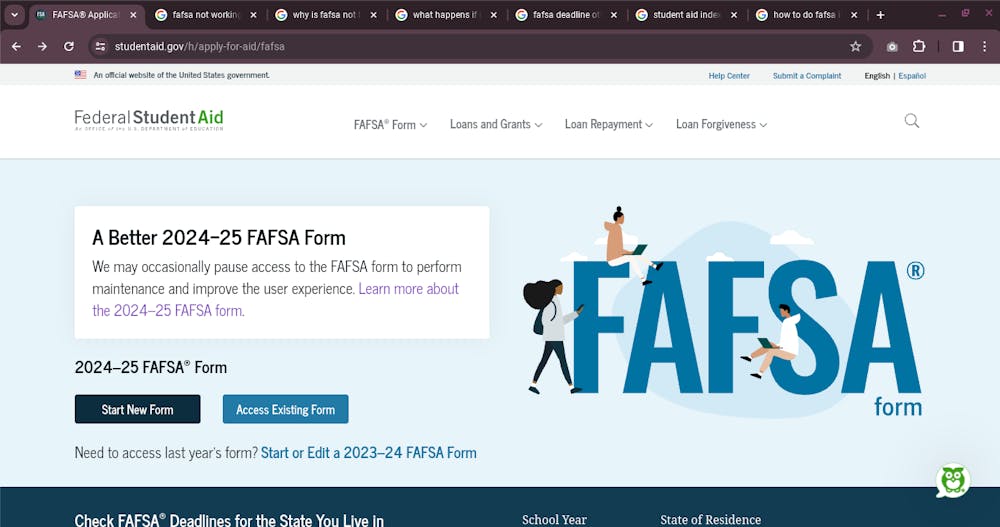While FAFSA usually becomes available in Oct. 1, there are some significant changes this year intended to provide increased eligibility for federal aid that delayed its release until Dec. 31. Additional errors and adjustments have presented further delays for students and schools alike.
The FAFSA or the Free Application for Federal Student Aid determines whether a student is eligible for federal aid, such as a Pell Grant or work-study. The FAFSA is utilized by universities to further determine the amount of institutional aid, such as scholarships or grants, that a given student may receive.
Before the FAFSA’s launch in December, schools were initially told it wouldn’t be until the end of January before they received FAFSA data.
However, on Jan. 23, the Department of Education announced a late inflation correction that is expected to provide an additional $1.8 billion in federal aid, though this has now delayed the delivery of FAFSA data until March.
For students, especially high school seniors in the midst of making college decisions, the late release has not only reduced the amount of time they would normally have to complete the form, subsequent adjustments will also affect the timing of award offers from schools, which can be crucial in college decisions.
Due to the compressed timeline and challenges presented by the new FAFSA for the 2024-25 school year, Otterbein’s FAFSA filing deadline has been extended from Jan. 31 to March 31.
According to Kirsten Crotte, senior director of enrollment and financial aid, Otterbein usually gets financial aid offers out to students in mid-January, but she says the financial aid office is doing its best to prepare for the new FAFSA.
“Every school is in the same boat right now. Nobody has data. So it's not just an Otterbein issue...it's across the board. So it's a real shame that these students are going to have less time to consider costs before they make their big decision of where they're going to go to school," Crotte said. Crotte said the financial aid office is preparing as much as they can, but can;t move much further without data to test the system.
The new FAFSA, however, was originally intended to be a simplified process that expanded federal aid eligibility.
While the FAFSA previously included over 100 questions, the FAFSA Simplification Act, passed by Congress in late 2020, aimed to streamline the FAFSA, reducing the questions to as few as 36.
Further, the new FAFSA utilizes new formulas for determining student aid, which the Department of Education claims will expand Pell eligibility for 610,000 students from low-income backgrounds.
While the FAFSA of years past utilized the Expected Family Contribution (EFC) to help estimate a student’s ability to pay for college, the new FAFSA employs a similar tool called the Student Aid Index (SAI), which ranges as low as –1500, indicating the greatest need.
Similarly to the EFC, the SAI will be used alongside other variables, including the Cost of Attendance (COA) and Other Financial Assistance (OFA), to determine a student’s eligibility for aid.
However, the SAI differs from the EFC in a few key ways, which may affect the amount of aid a student is eligible for.
For most students, the new FAFSA will increase their financial aid eligibility since the formula increases Income Protection Allowance (IPA), or the amount of income excluded from educational expenses.
However, students with siblings in college may see their aid reduced since the new FAFSA no longer accounts for the number of students in college. This leaves these students’ total aid to institutional discretion.
In reflecting on her own college decisions, Junior art and journalism major Alina Baer, said financial aid has played a role in her decision makings. She hopes Otterbein provides more information when it is available.
“Keeping everyone updated and involved is important, so everyone knows what’s going on because some people may not be always getting the information,” said Baer
For Otterbein students, Crotte says the university will try to reduce negative impacts from the new FAFSA.
“There will be a handful of students who will see their SAI go up significantly, and we don't want them to be penalized for the change in the way things are being calculated,” Crotte said. “So institutionally, we hope to support them very similarly to how we have in the past.”
Since many of Otterbein’s scholarships, including the Opportunity Scholarship, require a FAFSA filing, students are encouraged to complete the FAFSA as soon as possible.
For students who have yet to fill out their FAFSA, financial aid counselors will be available in Library 200 from 1-3 p.m. every Friday through March 1.








